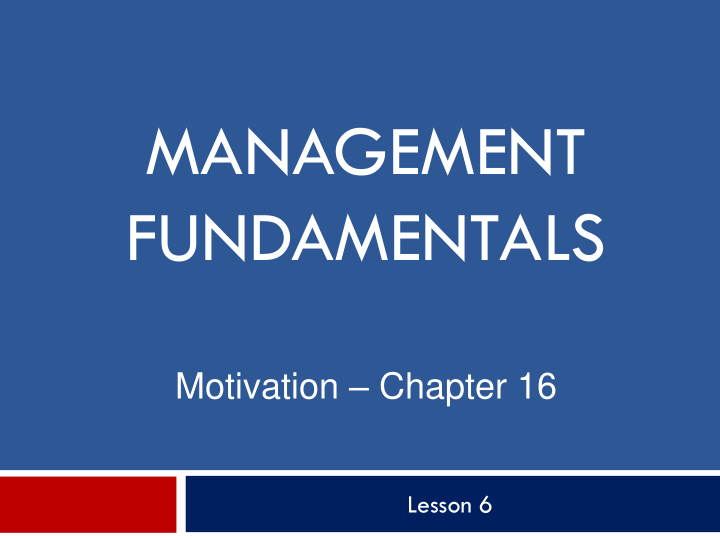



MANAGEMENT FUNDAMENTALS Motivation – Chapter 16 Lesson 6
Motivational triggers (forces) Forces either intrinsic (internal benefits) or extrinsic (external benefits) to a person that arouse enthusiasm and persistence (focus) E.g. Motivated by …. rewards (Extrinsic) the appreciation and recognition (Intrinsic)
Question: What benefits an organization can get by motivating its employees?
Theories related to Motivation
Theories of Motivation Hierarchy of Needs Theory Two factor Theory Expectancy Theory Goal Setting Theory Note: ERG theory, Equity Theory Self-reading
Page 530 Maslow’s Hierarchy of Needs Humans have 5 types of needs • Physiological needs • Safety needs • Social needs (Belongingness Needs) • Esteem needs • Self-actualization The needs will be satisfied in a hierarchical order As per the order of fulfillment Abraham Maslow
Page 530 Maslow’s Hierarchy of Needs
Page 532 Two Factor Theory ( By Fedrick Hertzberg - 1959) Herzberg’s theory was based on a work study. He believed that job satisfaction can increase motivation 200 engineers/accounts were interviewed Two questions were asked Q1 - What factors can improve your job satisfaction? Motivating Factors Q2 - What factors reduce job satisfaction? Hygiene Factors
Page 532 Herzberg’s Two -Factor Theory
Theory X and Theory Y (Douglas McGregor) Theory X Assumes that employees dislike work, lack ambition, avoid responsibility, and must be directed and coerced to perform. Theory Y Assumes that employees like work, seek responsibility, are capable of making decisions, and exercise self- direction and self-control when committed to a goal.
Expectancy Theory
Page 539 Expectancy Theory in Motivation If employees are given rewards for their good performance they could be motivated to perform better Victor Vroom E.g. ‘Work hard” Achieve targets ‘Rewarded as the best salesman’ Effort Performance Reward
Expectancy Theory contd. Vroom suggested that there are 2 mental conditions (cognitive factors) which direct the motivated behaviour (effort) of a person in this context. They are Victor Vroom – Valence – Expectancy
Equity Theory Equity = Output (Reward) Input (Effort) Equity Theory Individuals compare their job inputs and outcomes with those of others and then respond to eliminate any inequities.
Equity Theory (cont’d) Distributive Justice Perceived fairness of the amount and allocation of rewards among individuals . Procedural Justice The perceived fairness of the process to determine the distribution of rewards.
Equity Theory (cont’d) Choices for dealing with inequity: Change inputs Change outcomes (increase output) Distort/change perceptions of self Distort/change perceptions of others Choose a different referent person Leave the field (quit the job)
Job Design for Motivation Job Simplification Job Rotation Job Enlargement Job Enrichment
Recommend
More recommend